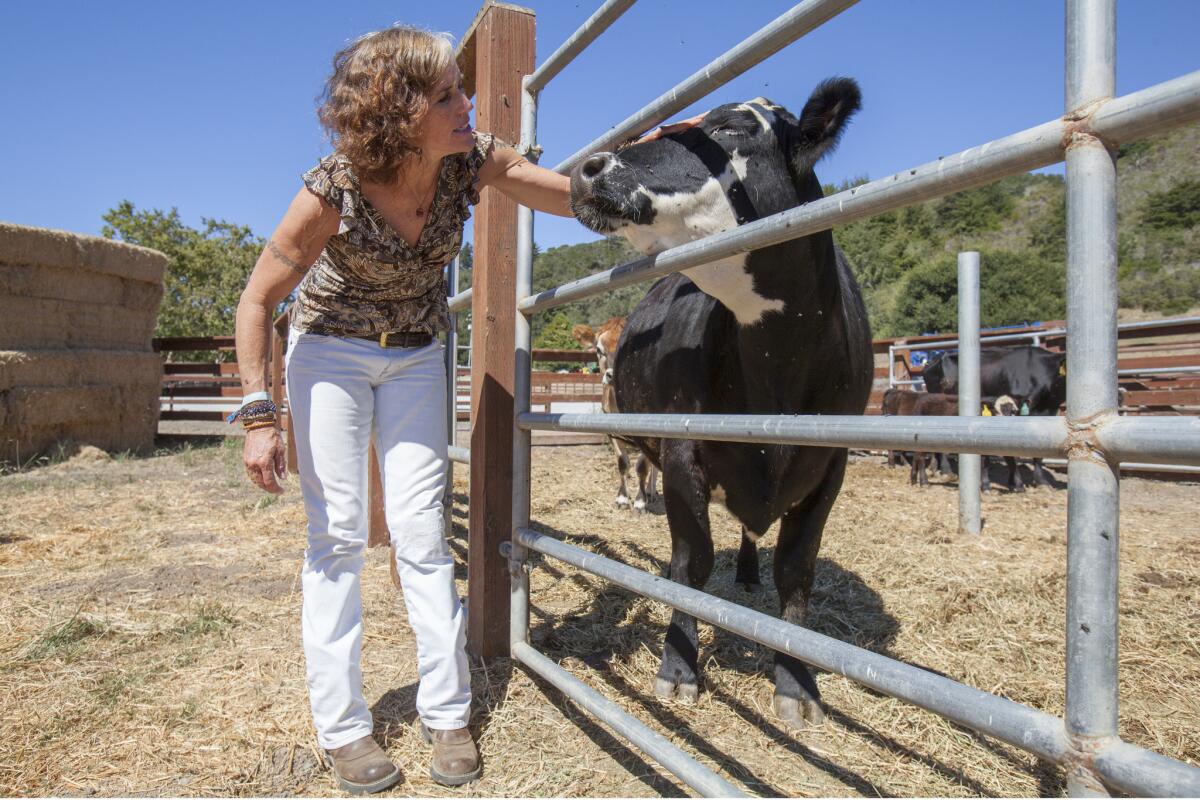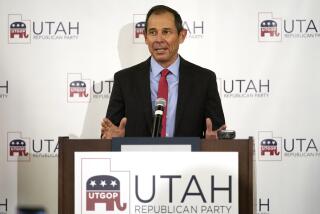Why Tom Steyer’s latest fight against climate change involves raising his own cattle

Kat Taylor runs a ranch in Pescadero, Calif., with her husband, billionaire Tom Steyer, where they are determined to prove that unconventional methods of raising cattle can yield surprisingly profitable - and sustainable - results.
Tom Steyer’s crusade to force politicians to confront climate change is well known, manifesting itself in millions of dollars of campaign funding, including the windfall he raised for Hillary Rodham Clinton recently in his San Francisco home.
Less well known is the billionaire’s crusade to force farmers to confront it.
At an 1,800-acre cattle ranch that Steyer and his wife, Kat Taylor, own near Half Moon Bay, they are plotting to upend agribusiness with the same precision – and even some of the same tools – that served Steyer well in the hedge fund business. They are also surprising some allies in the climate movement by cattle ranching at all. Many see the presence of massive numbers of cows on the planet as incompatible with efforts to contain global warming.
The couple have a different take.
“We would continue raising cattle even if no one ever ate another steak,” said Taylor. That’s how beneficial she and Steyer think these large farm animals can be. They want the cows to mimic the ancient migratory patterns of wild ungulates and naturally fertilize and aerate soil to reverse the mass erosion believed to be accelerating climate change.
Steyer and Taylor are among the ultra-rich climate activists whose impatience with the impact of food production on the environment has them moving beyond writing checks for research projects and scientific institutes to personally picking up cattle prods and pitchforks.
Former Oracle Chief Executive Larry Ellison, the world’s fifth-richest man, purchased nearly the entire Hawaiian island of Lanai with futuristic plans to revive a long-defunct pineapple-growing industry there by desalinating seawater with solar and wind power. On a farm in Arizona, Howard G. Buffett, son of the world’s third-richest man, Warren E. Buffett, is fine-tuning climate-friendly growing techniques with the help of a couple of oxen, which he brought on board to demonstrate how the practices could work on subsistence farms in Africa that have no tractors.
Back at TomKat Ranch, cattle are encouraged to roam the way large mammals had in the wild for thousands of years, in the hope of re-creating ecosystems in which the patches of land they temporarily visit are enriched by all the accompanying organisms, rather than degraded. During a recent visit, the cattle had roamed so far into the hills that ranch hands were unable to get a reporter out to see them. Steyer playfully suggested hopping on the ATVs parked nearby, but a handler reminded him that, well, he was a billionaire with a busy agenda and time was short.
The goal, Steyer explained, is to “sequester a lot of the carbon in the soil and, from a greenhouse gas standpoint and carbon standpoint … be a net plus.”
Steyer, Taylor and a staff of scientists and farmers are riding herd not just over cattle, but also accountants from PricewaterhouseCoopers. The number crunchers are meticulously analyzing whether there is merit to the couple’s theory about how cattle ranching and climate interact.
“We are picking apart the whole operation, looking at all the supply-chain effects, adding data collection, recruiting a data consortia,” said Taylor, the inspiration behind the ranch. Since the cows were AWOL, Taylor was talking over by the farm’s makeshift chicken pen, where scores of fluffy chicks chirped like mad on the parched field.
Steyer waved to a worker named Annie. “Her daughter got married here a year ago,” he said. “As her wedding gift, she raised and killed 100 chickens for the wedding dinner.”
The chickens feast on the insects attracted by the cattle herd’s manure. Self-sustainability is religion here. The billionaires who own the place won’t even buy food for the fish that swim around its aquaponic vegetable growing tanks. Instead, they have a partnership with a firm called Inka Biospheric Systems, which recycles waste on the farm into homemade fish food.
NEWSLETTER: Get the day’s top headlines from Times Editor Davan Maharaj >>
By trade, Taylor is the leader of a community bank oriented toward low-income borrowers, but she talks about potential for green innovation in farming with the granular detail of a doctoral student in agricultural science. Conversation with her jumps from nematodes to rhizomes to how “the animals stamping with their hooves and manuring stimulates the microbial community to get ever busier.”
As they strolled through the postcard-pretty property, Steyer would chime in every so often to bring the conversation back to 60,000 feet.
“There are huge questions here,” he said from across the large table in one of the outbuildings that didn’t look like much from the outside, but inside could have been the photo shoot set for a Restoration Hardware catalog. “This could be a very good thing, or it could be a very bad thing. Determining what it actually means in the real world, not what people hope it means or fear it means, is pretty important.”
The couple initially purchased the ranch in 2002 to help preserve the landscape, provide educational opportunities for local students and boost the farm-to-fork movement. Its prior owners were an Austrian count and countess who held parties and family reunions on the property until the count died of a heart attack and the countess was too heartbroken to return. It fell into terrible disrepair, Taylor said, used as a dumping ground for cars and other objects, its topsoil stripped and sold.
The vision for the land evolved as Taylor and Steyer grew increasingly interested in conservation theory that holds that herds of large, heavy animals like bison running across the earth had once helped churn rich plant material into the soil, creating a hospitable environment for what Taylor calls a “massively symbiotic symphony of nature.”
Regardless of whether the grazing technique helps the environment, the couple know it is not going to be widely embraced unless it makes business sense. The audit will examine whether the practice can be scaled beyond boutique operations like Leftcoast Grassfed, the ranch’s organic beef business that serves mostly farm-to-fork enthusiasts.
“You can think of this ranch as a big scientific experiment,” Steyer said. “We have the hypothesis and we are trying to rigorously test and measure it.”
Agriculture will be refashioned in the coming decades, predicts Ellison, who has been more circumspect about his plans for Lanai. His desalination project, he told an Oracle conference last year, “is supposed to be a model for the next generation.”
Out in Arizona, Buffett’s approach is decidedly less radical. He’s a firm believer that the chemicals and other products made by giant companies like Archers Daniels Midland – where he once worked – are essential to growing enough food, particularly on increasingly parched land.
Buffett is the son of a billionaire investor, but his passion is not high finance – it’s farming. He’s been a farmer for decades. The foundation he created, funded with some $2 billion from his father, is focused on global food security and sustainability.
Key to his work on the Arizona exhibition farm are Ike and Earl, the oxen. They were not easy to find, Buffett said, as the only practical purpose for oxen in America tends to be for history buffs who want to demonstrate how life was lived in times past.
“I thought for a while we were the only ones in Arizona who had them,” he said. “But there is a guy a couple of hours from here and he has all the old yokes and equipment and shows up at agriculture fairs.”
Like Steyer and Taylor, he says farmers need to adopt new thinking on what they do to their soil. He’s an evangelist for no-till farming, in which fields are left unplowed and covered with plant residue to keep it nutrient-rich and lessen the need for synthetic fertilizers. Such soil, he says, is a sponge for carbon dioxide that would otherwise be released into the atmosphere and accelerate global warming.
“I can prove all day long that this works,” he said. “When someone argues with me, I just reverse the question. I ask what solutions they have. How are they going to help farmers survive climate change?”
Twitter: @evanhalper
Sign up for our free political newsletter, Essential Politics
ALSO
Wal-Mart lays off 450 workers at headquarters
Overturned truck spills hot asphalt on 71 Freeway, blocking all southbound lanes for hours
Job growth slows sharply to 142,000; unemployment rate stays at 5.1%
More to Read
Get the L.A. Times Politics newsletter
Deeply reported insights into legislation, politics and policy from Sacramento, Washington and beyond. In your inbox three times per week.
You may occasionally receive promotional content from the Los Angeles Times.







